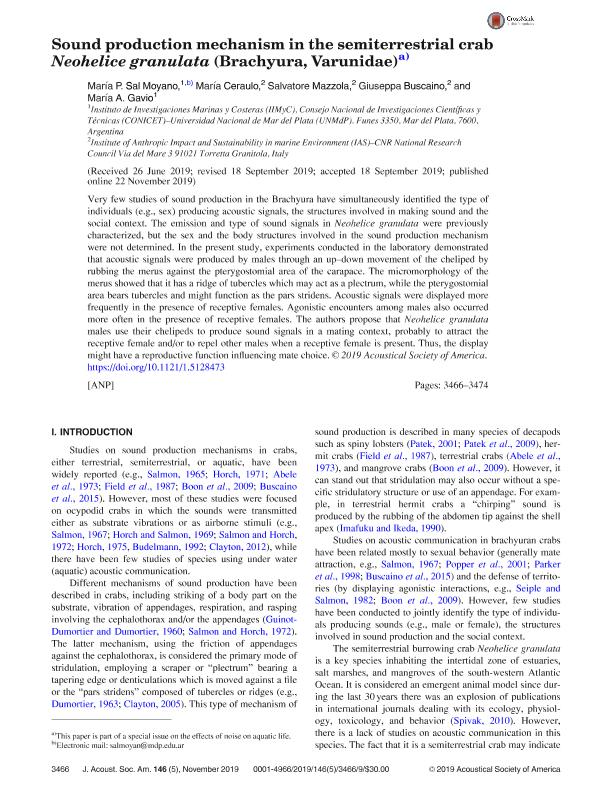Mostrar el registro sencillo del ítem
dc.contributor.author
Sal Moyano, María Paz

dc.contributor.author
Ceraulo, Maria

dc.contributor.author
Mazzola, Salvatore

dc.contributor.author
Buscaino, Giuseppa

dc.contributor.author
Gavio, Maria Andrea

dc.date.available
2021-01-11T15:36:45Z
dc.date.issued
2019-11
dc.identifier.citation
Sal Moyano, María Paz; Ceraulo, Maria; Mazzola, Salvatore; Buscaino, Giuseppa; Gavio, Maria Andrea; Sound production mechanism in the semiterrestrial crab Neohelice granulata (Brachyura, Varunidae); Journal of Animal Ecology; Journal of the Acoustical Society of America; 146; 11-2019; 3466-3474
dc.identifier.issn
0001-4966
dc.identifier.uri
http://hdl.handle.net/11336/122237
dc.description.abstract
Very few studies of sound production in the Brachyura have simultaneously identified the type of individuals (e.g. sex) producing acoustic signals, the structures involved in making sound and the social context. The emission and type of sound signals in Neohelice granulata were previously characterized, but the sex and the body structures involved in the sound production mechanism were not determined. In the present study, experiments conducted in the laboratory demonstrated that acoustic signals were produced by males through an up-down movement of the cheliped by rubbing the merus against the pterygostomial area of the carapace. The micromorphology of the merus showed that it has a ridge of tubercles which may act as a plectrum, while the pterygostomial area bears tubercles and might function as the pars stridens. Acoustic signals were displayed more frequently in the presence of receptive females. Agonistic encounters among males also occurred more often in the presence of receptive females. We propose that Neohelice granulata males use their chelipeds to produce sound signals in a mating context, probably to attract the receptive female and/or to repel other males when a receptive female is present. Thus, the display might have a reproductive function influencing mate choice.
dc.format
application/pdf
dc.language.iso
eng
dc.publisher
Journal of Animal Ecology

dc.rights
info:eu-repo/semantics/openAccess
dc.rights.uri
https://creativecommons.org/licenses/by-nc-sa/2.5/ar/
dc.subject
ACOUSTIC SIGNALS
dc.subject
SOUND STRUCTURES
dc.subject
CRUSTACEANS
dc.subject
REPRODUCTIVE CONTEXT
dc.subject.classification
Otros Tópicos Biológicos

dc.subject.classification
Ciencias Biológicas

dc.subject.classification
CIENCIAS NATURALES Y EXACTAS

dc.title
Sound production mechanism in the semiterrestrial crab Neohelice granulata (Brachyura, Varunidae)
dc.type
info:eu-repo/semantics/article
dc.type
info:ar-repo/semantics/artículo
dc.type
info:eu-repo/semantics/publishedVersion
dc.date.updated
2020-11-26T17:47:58Z
dc.journal.volume
146
dc.journal.pagination
3466-3474
dc.journal.pais
Estados Unidos

dc.description.fil
Fil: Sal Moyano, María Paz. Consejo Nacional de Investigaciones Científicas y Técnicas. Centro Científico Tecnológico Conicet - Mar del Plata. Instituto de Investigaciones Marinas y Costeras. Universidad Nacional de Mar del Plata. Facultad de Ciencias Exactas y Naturales. Instituto de Investigaciones Marinas y Costeras; Argentina
dc.description.fil
Fil: Ceraulo, Maria. Consiglio Nazionale delle Ricerche; Italia
dc.description.fil
Fil: Mazzola, Salvatore. Consiglio Nazionale delle Ricerche; Italia
dc.description.fil
Fil: Buscaino, Giuseppa. Consiglio Nazionale delle Ricerche; Italia
dc.description.fil
Fil: Gavio, Maria Andrea. Consejo Nacional de Investigaciones Científicas y Técnicas. Centro Científico Tecnológico Conicet - Mar del Plata. Instituto de Investigaciones Marinas y Costeras. Universidad Nacional de Mar del Plata. Facultad de Ciencias Exactas y Naturales. Instituto de Investigaciones Marinas y Costeras; Argentina
dc.journal.title
Journal of the Acoustical Society of America

dc.relation.alternativeid
info:eu-repo/semantics/altIdentifier/url/https://doi.org/10.1121/1.5128473
dc.relation.alternativeid
info:eu-repo/semantics/altIdentifier/doi/http://dx.doi.org/10.1121/1.5128473
Archivos asociados
